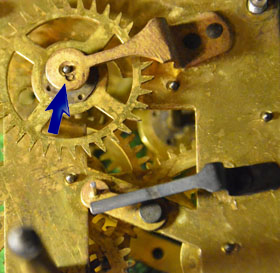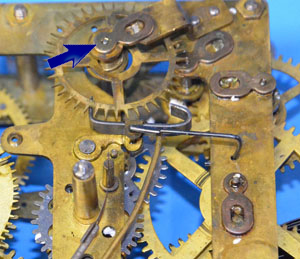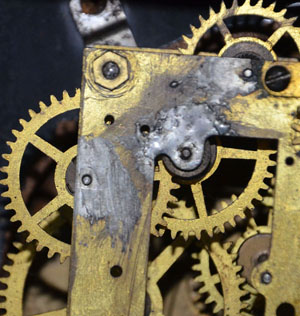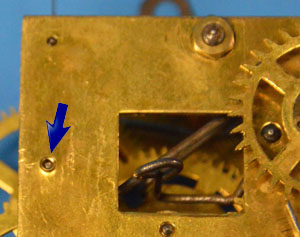
Clock Repair
Clock repair is a passion of mine. When I work on one, I want it to be as close as possible to what the original maker intended. In my experience, Iíve seen many methods of repairing clocks, almost all of which I disagree. For instance, Iíve run into situations where the person doing the repairs just puts an abundant amount of oil on the works to get it running again. This leaves dirt and grime that has built up over the years, which will continue to act as an abrasive. This will only cause more damage as the clock continues to run.
The workings of a timepiece will always see friction through forces put out by the springs or weights, which are needed to power the clock. These forces cause the plates that the pivots run in to wear. (Pivots are at the end of the arbors that hold the gears). Eventually, this abrasion will cause the gears to mesh together too closely, and stop the clock.
There are many ways to repair the worn pivot holes in the plates of the works, but only one correct way that I know of. Included are photos of a number of incorrect processes that I have observed. First is the hole-closing tool. As the pivot wears in the plate, it always wears in the direction of the force exerted by the gear that is transferring power. A hole-closing tool is a punch that is used on the worn side of the pivot hole to push material in to replace the plate material that has worn away. This method never produces neither a concentric hole nor a complete one. This method only causes more damage to your timepiece.

The next photo shows another method, which makes me shudder whenever I see it. This is the method of drilling a hole in the plate and screwing in a strap. This strap has a correct size pivot hole, which is centered over the original pivot hole. There are two problems with this method. First, they have done some real damage to the works with all the extra holes they are drilling that were never meant to be there. Second, the strap only catches the very end of the pivot and is therefore not properly supporting the arbor.

The third and probably most creative method Iím showing here is solder. This is a great example of the extent that someone will go to try to fix a clock without really knowing how. Solder was used to try to close the worn pivot hole, and I imagine was drilled out to get the pivot to fit again. The fact that this clock ever worked again is a great surprise to me. And what a mess it was to clean it up!

The proper method to repair a worn pivot hole is to bush it. The hole is opened so that it is again centered on the original pivot hole and a brass bushing is pressed in. This gives the pivot full contact on the plate in the original position, while also giving the original oil well on the outside of the plate to hold the proper amount of clock oil to lubricate the pivot. This is certainly more time consuming than using a hole-closing punch, but brings the pivot contact back to its original condition, and is almost indiscernible to anyone other than another trained clockmaker.

When I work on your clock, you can expect the following:
1. I will completely disassemble and inspect the works, looking for any problems or wear that need to be addressed.
2. I will clean and rinse the parts in clock cleaning and rinse solution, and then again inspect for any problems.
3. I will bush any pivot holes that are worn and fix any other problems with parts from the period of the clock or parts made to the same specifications as those from the original.
4. I will re-assemble the works, adjust, and run for one to two weeks to assure proper operation and regulate to the proper time keeping that could be expected from the timepiece when it was new.
5. I will guarantee the work for two years from the date of my service.
My goal is to have you enjoy your antique clock as much as I enjoy mine. These clocks are a beauty from the past and give so much splendor and charm to a home. I look forward to working with you.